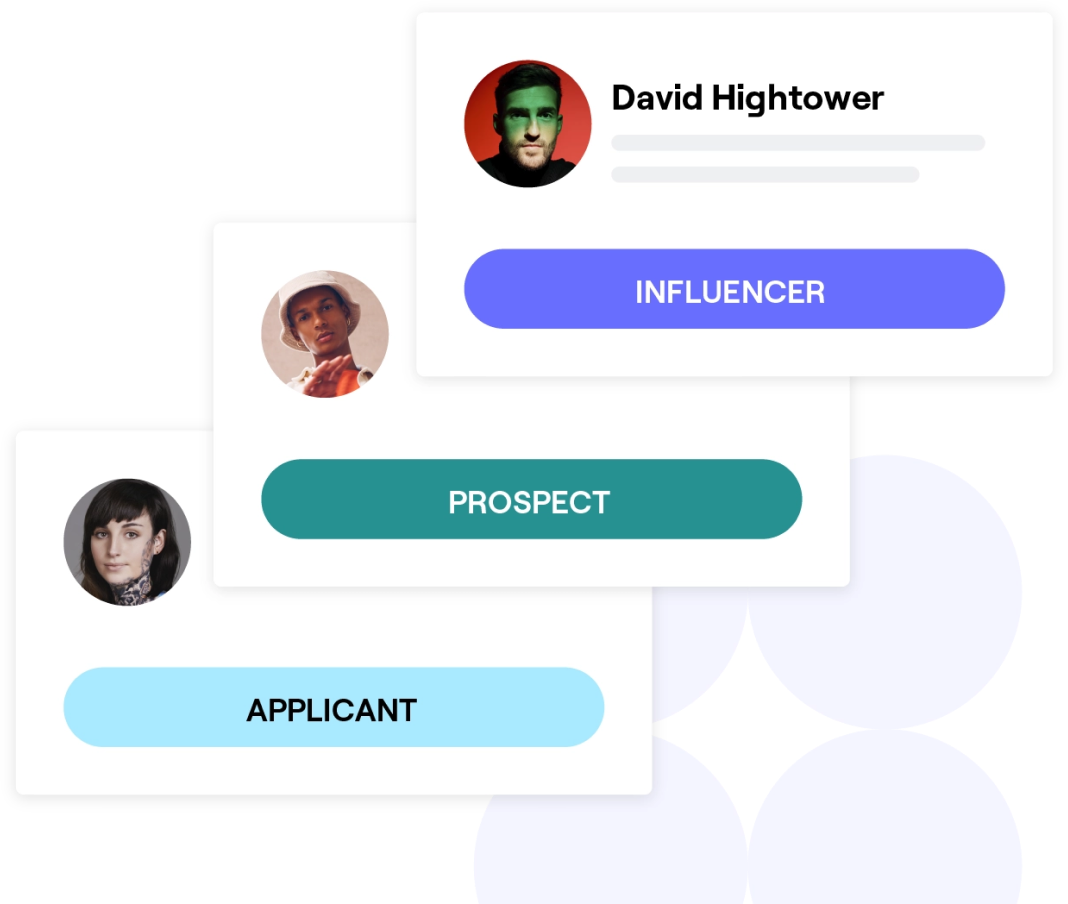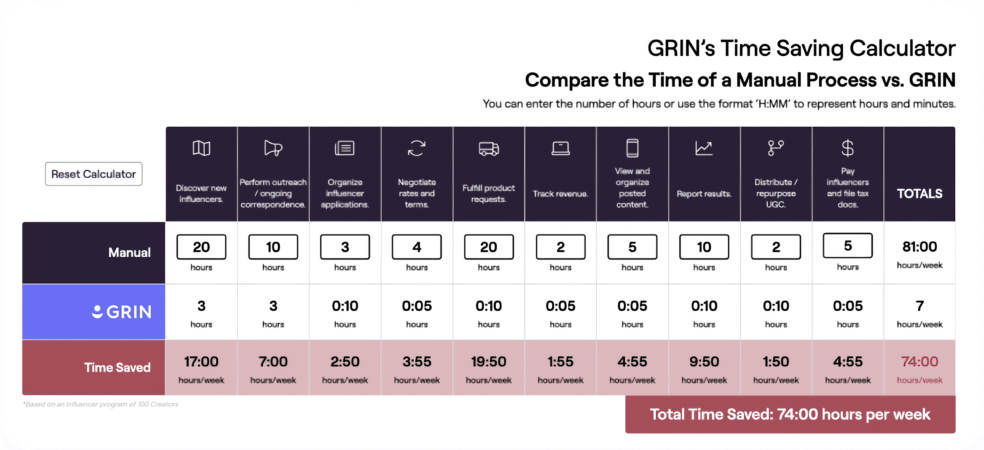Whether you’re new to the influencer marketing scene or currently running a campaign, it’s important to track your results.
Skipping the influencer reporting stage opens your brand up to the potential for losing money on campaigns without even knowing it. And if you aren’t making updates to your campaign based on your results, you’re leaving money on the table.
From another angle, influencer marketing can be a big investment, and if you aren’t able to prove ROI to your key stakeholders, they’re not going to be happy.
However, tracking campaigns and influencer reporting results are easy if you have the right tools, and we’re sharing our favorite (free) templates for completing these essential tasks.
How to track data throughout the entire influencer campaign
1. Determine your objectives and KPIs.
One of the most crucial elements of any campaign planning is setting your marketing goals and KPIs.
While your goals provide a high-level overview of what you hope your influencers will accomplish for your brand (i.e., sales, brand awareness, website traffic, increased followers, UGC, etc.), key performance indicators (KPIs) break each goal down into actionable milestones.
With each KPI, you will achieve the best results if you assign a deadline and campaign metric. That way, you will know at all times how well your campaign is working in relation to your marketing objectives.
2. Research content creators.
The next step is to find content creators who can help you reach your target audience.
This is one of the most important steps in running an effective influencer marketing campaign. Even if you do everything else right, it could all go to waste if you do not collaborate with the right influencers.
The first step in finding the right influencer is to make a list of content creators in your niche. If you aren’t currently using an all-in-one Creator Management platform, you can do this by searching your target social platforms. You could also ask your existing customer base who they follow and trust. If you get the same answer a few times over, you should probably approach these people.

The next step is to research the creators by looking at their follower base, engagement levels, area of expertise, etc. However, the most important criteria are their relevance and strategic fit with your brand. The influencers you collaborate with should already be interested in topics related to your products.
When reaching out to a creator for the first time, consider sending them a short, direct message over their primary social channel. Once you’ve made contact and confirmed that they are interested, you can transition that creator to email to begin negotiations.
3. Track campaign results regularly.
When you consistently monitor, measure, and analyze your campaign results, you can understand what’s working and what’s not. That begins with tracking influencer content.
If you’re using the spreadsheet method, check out our influencer content bank template and content creator performance report template below and download copies to start using them.
For those using a Creator Management platform like GRIN, you can utilize tools that help you pull content automatically so that you don’t have to manually dig for posts during your campaign.
4. Optimize your creator campaign.
Your campaign reports help evaluate the success of your campaign. Not only do they prove influencer ROI, but they also give you and your team insights on what works, what doesn’t work, and what new tactics you should try.
Check your team’s performance against your established KPIs. Are your content creators meeting or exceeding these? Great! If they’re falling below, there’s no need to panic—just see what tweaks you can make.
For example, maybe most of your creators are doing great, but one person’s results are less than you hoped for. Perhaps they may not be the best fit for your current campaign. In this case, consider ending the partnership and searching for other creators similar to the ones excelling.
Or, if results are low across the board, consider other optimizations. If you gave rigid guidelines and the content seems disingenuous, consider offering your influencers more creative freedom.
Once you optimize, it’s time to go back to #3 in this process and start tracking data again.
5. Record results for key stakeholders.
Whether you’re reporting monthly on an evergreen program or presenting results just once at the end of a campaign, you’ll want to be sure to represent the influencer reporting data clearly and concisely for key stakeholders.
Focus on those KPIs you determined earlier and bring them to life in your report. For example, if your goal was to earn 50+ pieces of influencer-generated content to repurpose, share some of your favorite posts.
And as with anything that requires an investment, be sure to share the ROI of your program.
How to create an influencer marketing strategy presentation
When creating any presentation, it’s essential to focus on the key highlights and depict them in a concise yet compelling way.
When building out a deck, first things first: your KPIs. Incorporate these near the beginning to keep your stakeholders engaged and highlight your most important results.
From there, you can use charts or graphs to depict changes in other key metrics.
Try to avoid huge blocks of text, and keep things short and sweet.
Managing influencer campaigns: Manual vs. automated
Brands that manage their influencer relationships manually must build and maintain a system to track their creators, product gifts, budgets, campaign performance, and more. That said, many brands have found automated solutions help them take their campaign management to the next level.
Who should manage their campaigns manually?
For brand new influencer programs, the manual approach works best.
In an episode of GRIN’s Brands Talking Influencers fireside chat with special guest Andrea Faulkner Williams, co-founder of Tubby Todd, the infant skincare company owner shared what it was like building an influencer program from scratch.
“At first, we felt like we were giving over half of our product away, and so we really needed to keep track of who we were giving it to, and did they like it, and did they talk about it, and what was their address … We had that information on Google Docs.”
-Andrew Faulkner Williams, Co-Founder & Head Mama at Tubby Todd Bath Co., via the Brands Talking Influencers webinar
For newer programs on a shoestring budget, you’ll want to develop your own tracking solutions and lean on your product’s value. Andrea continues,
“We had a really careful Google Sheet that had a column for name, email, their handle, how many followers they had, and we broke them into tiers from the very beginning.”
-Andrew Faulkner Williams, Co-Founder & Head Mama at Tubby Todd Bath Co., via the Brands Talking Influencers webinar
Spreadsheets and cloud drives will help you stay organized with your product gifts. Additionally, you can use spreadsheets to help you track:
- Content creator prospects (those you are vetting or are inviting to join a campaign)
- Current campaign performance
- Total program performance
- Content library
When should you automate your influencer workflow?
Brands with a team of 20 or more recurring influencer partners should seriously consider investing in an influencer reporting tool. These brands typically have the numbers to prove influencer ROI to justify investing in a robust platform.
“The spirit that we were looking to support was ‘automate, automate, automate,’ so that we could personalize what we wanted. We know that if we are able to automate a lot of these processes, then we can give that personal time [to each creator partner], and that’s what’s going to differentiate us.”
– Greg Tetzlaff, Head of Product Content and Industry Influencers at Nutrabolt, via the GRIN Gets Real podcast
Manual vs. automated influencer campaign management: Pros & cons
The manual approach
- Pros
- Cost-effective (free)
- More control for new programs
- Cons
- Time-intensive
- Non-intuitive
- Difficult to maintain with content creator teams of 20 or more
The automated approach
- Pros
- Do more in fewer clicks
- One person can do the work of multiple people
- More time to personalize the partnership experience for each content creator
- Run more campaigns more often
- Easier and more accurate performance tracking
- Integration with multiple software tools
- Cons
- Medium-to-high upfront costs
Use these influencer marketing reporting templates to measure results manually.
Getting started with manual tracking can seem intimidating, so we’re sharing some free templates to help you out.
Influencer content bank template
Utilize this template to keep track of every piece of influencer-generated content from your campaign. Here’s how to use it:
- Include the general information, like the campaign name and content creator’s name.
- Next, add details about each post, including the platform it lives on, the date it was posted, and all metrics. When filling out the influencer’s number of followers, only use the amount on the platform the post lives on. For example, if the content is an Instagram post, only pull their number of Instagram followers.
- Let the magic begin. Once you fill in the necessary fields, the engagement rate will auto-calculate for you.
Download: Influencer Content Bank Template
Content creator performance report template
This template is perfect for measuring the results of each content creator as a whole rather than the performance of each of their posts. Here’s how to use it:
- Include the general information, like the campaign name and content creator’s name.
- Calculate the number of content pieces each influencer created and the total number of impressions and engagements.
- Fill in the rest of the sheet with data from your ecommerce platform.
Looking for more resources to help you get started with influencer campaign reporting?
Find inspiration with these influencer marketing strategy examples.
Sometimes, it can be hard to know where to start. With so many directions you could take with your influencer marketing campaign, the decision can be downright overwhelming.
However, drawing inspiration from those who have excelled in the creator economy and then customizing tactics to make them your own can help you overcome indecision. Check out examples from leaders in the influencer marketing field.
Lume Cube: Content creation
As a startup, Lume Cube, a brand of portable, user-friendly lights for photography and videography, knew it needed to create brand awareness. In response, they turned to influencer marketing.
The brand joined forces with personalities like professional skater Ryan Sheckler and surfer Jamie O’Brien who were known for creating dynamic content that showed off their action-packed lifestyles. From there, the program took off. Over time, they partnered with more creators, ultimately generating over 5,000 pieces of content.
SlumberPod: Code conversions
SlumberPod, a brand selling innovative sleep canopies for babies, focused on creator partnerships right from the start. Since so many of their sales came through word-of-mouth, they wanted to level up that approach with influencer marketing.
Using product seeding and affiliate codes, SlumberPod leveraged creators to earn over 10,000 code conversions resulting in 7-figure revenue.
Key takeaway: Influencer reporting allows you to optimize your campaign continuously.
Particularly if your program is new, it can feel overwhelming to keep track of all the key campaign data, such as content, reactions, shares, sales, etc. There are many ways to simplify tracking by using branded hashtags, affiliate links, and coupon codes. You can also ask your influencers for help so that you can properly attribute results to the right creators.
If you diligently track campaign performance, you’ll quickly spot ways to refine your program and increase your ROI. Additionally, keeping tabs on those influencer reporting metrics will help you select the right solutions for your creator management tech stack.
Find out how much time you can save with an influencer marketing software: GRIN’s Time Saving Calculator

![Influencer Reporting Best Practices for Demonstrating ROI [+ Free Influencer Report Templates] 1](https://grin.co/wp-content/uploads/2022/05/IM_SA_What_Is_Influencer-Generated_Content_and_How_to_Use_It_to_Help_Your-Brand_2022-Q2-04-FINAL_Stock_Image_Feature_960x640.webp)
![Influencer Reporting Best Practices for Demonstrating ROI [+ Free Influencer Report Templates] 2](https://grin.co/wp-content/uploads/2021/04/20-KPIs-For-Your-Influencer-Marketing-Campaign.jpg)
![Influencer Reporting Best Practices for Demonstrating ROI [+ Free Influencer Report Templates] 3](https://grin.co/wp-content/uploads/2021/03/reporting-ROI.jpg)













